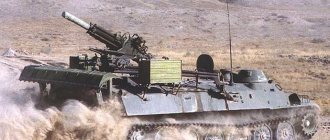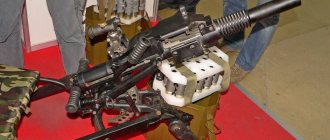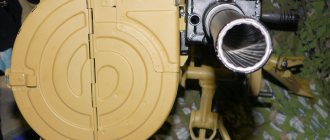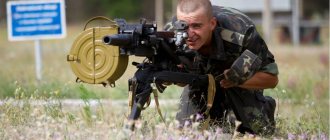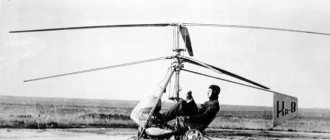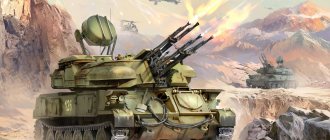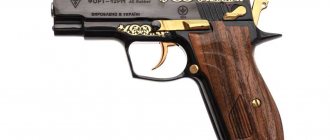At the very beginning of the twentieth century, one of the most effective parts of infantry weapons was an unusual artillery weapon, the importance of which has not diminished to this day. For example, the “Cornflower”, created in the distant seventies, is a unique mortar that is still in service with the Russian Armed Forces. This eighty-two-millimeter caliber weapon fires one hundred and twenty minutes per minute.
Start
"Cornflower" is a mortar that can fire along a flat trajectory, which is not typical for this type of weapon. Outwardly, nothing distinguishes it from conventional artillery, but once you look at the ammunition, it immediately becomes clear how complicated it is. “Cornflower” is a combat mortar, and its history is covered with glory. It was produced in the USSR and not only: first Hungary acquired a license for its release, then it was simply copied in China (W99). In 2014, this mortar was adopted by Kazakhstan as a self-propelled weapon based on the BMP-1.
“Cornflower” is a mortar that has several modifications, since attempts were constantly made to make it a self-propelled weapon and install it on a variety of types of vehicles and military equipment. Today this weapon is fighting in Ukraine - on both sides; it is also in service with the PRC and Vietnam. And, despite the abundance of the latest artillery weapons, all sorts of “delights” of modern technologies in the armies of the world, our country is not yet going to write off the Cornflower mortar.
Southern Military District of Russia: field training of artillerymen began in the mountains of Armenia
Field training for artillerymen has begun / Photo: s39.radikal.ru
At the high-altitude training complex Alagyaz in the Republic of Armenia, about 400 military personnel of the artillery units of the Russian military base of the Southern Military District began field training. The training camps are held at an altitude of over 2 thousand meters above sea level and will last until the end of March of this year.
The duration of the training day at field training is 10 hours, where 50% of classes will be conducted at night.
Self-propelled howitzer “Gvozdika” / Photo: ru.wikipedia.org
During the month-long training course, the artillerymen will undergo classes in tactical, special and technical training, as well as in driving modern types of military equipment, shooting and fire control of weapons. The training events involve self-propelled howitzers "Gvozdika", multiple launch rocket systems "Grad", mortars "Podnos" and anti-tank missile systems "Konkurs", as well as unmanned aerial vehicles of modern reconnaissance complexes "Navodchik-2".
During the training of artillery units, special attention will be paid to training command personnel of all levels to make decisions on the battlefield and change firing positions.
The training of the artillerymen of the Russian military base will end with tactical exercises with live-fire, where the tasks of fire destruction of objects and manpower of a mock enemy in mountainous areas will be completed, the press service of the Southern Military District reported.
BM-21 "Grad"
- Soviet multiple launch rocket system based on the Ural-375 vehicle. This multiple launch rocket system is designed to hit a wide variety of targets: open and covered manpower, equipment, armored personnel carriers, artillery batteries and command posts. This system is an improved analogue of the Katyusha.
Photo: IA “ARMS OF RUSSIA”, Alexey Kitaev
The Grad divisional system was developed in 1960 to replace the BM-14. "Grad" was already equipped with a 122-mm high-explosive fragmentation projectile, which is capable of destroying manpower, military equipment and enemy resistance units. The Grad MLRS was adopted for service in 1963. But mass production of this equipment began in 1964 in the city of Perm.
The Grad MLRS was manufactured in the USSR for a long time, and is currently the most common vehicle of this class. China, Egypt, Iraq, Iran, Romania and South Africa are also involved in the production of Grads. Today, the Grad MLRS is in service in more than 30 countries around the world.
The Grad MLRS includes: a BM-21 combat vehicle, a fire control system, 122-mm unguided rockets, and a 9T254 charging vehicle. To prepare shooting data, a 1B110 “Bereza” control vehicle based on the GAZ-66 vehicle is also used.
Story
Such a weapon was developed back in 1946, as soon as the war ended. The 2B9 "Vasilek" automatic mortar was able to use the energy of the recoil barrel to operate the automation, which was already quite widely used in artillery, but not for mortars. This development was called KAM and was quickly adopted.
According to the plans, KAM was planned to be installed in long-term fortification structures, for example, in casemates. But it took several years to create a field version of the eighty-two-millimeter mortar with automatic equipment, and it was created, but for unknown reasons was not adopted for service. And only in 1970 the 2B9 “Cornflower” mortar appeared in the Soviet army.
Notes
- Shirokorad A. B.
Domestic mortars and rocket artillery. - Minsk: Harvest, M.: AST, 2000. - P. 167. - ISBN 985-13-0039-X (Harvest), 5-17-001748-0 (AST). - Shirokorad A. B.
Domestic mortars and rocket artillery. - Minsk: Harvest, M.: AST, 2000. - P. 160-161, 163. - ISBN 985-13-0039-X (Harvest), 5-17-001748-0 (AST). - ↑ O'Malley T. J.
Modern artillery: guns, MLRS, mortars. - M.: EKSMO-Press, 2000 (translated from English; original edition - 1994). - P. 146. - ISBN 5-04-005631-1. - Evteev I.M.
The flames were still rising... Essays. - M.: Inter-Libra, 1997. - P. 221 - 264 p. — Circulation 1000 copies. — ISBN 5-86490-060-5. - Shirokorad A. B.
Domestic mortars and rocket artillery. - Minsk: Harvest, M.: AST, 2000. - P. 87, 163, 166-167. — ISBN 985-13-0039-X (Harvest), 5-17-001748-0 (AST). - Depending on the type of fuse, the weight and, accordingly, the firing range of fragmentation and smoke mines changed; mines with M-1 and M-4 fuses weighed 0.21 kg more than mines with MP-82 and M-6 fuses.
- Min and Max firing ranges are given for the following conditions: sea level; pressure 760 mmHg; air temperature, weapon barrel and powder charge +20°C; dry air without a significant amount of solid particles (snow, sand) in it; calm; in practice, the listed factors can significantly influence the firing range in both one and the other direction.
- ↑
- Konstantin Chuprin
Military power of the Celestial Empire. The armed forces of the People's Republic of China today and tomorrow. - Minsk: Harvest, 2007. - P. 744. - ISBN 978-985-16-0226-7. - ↑
- Major General Yu. P. Prishchepo.
About licenses and around them // “Equipment and weapons”. - 2007. - No. 2. - P. 2-9. - The Military Balance 2022. - P. 407.
Modifications
Initially, this gun was designed with a water-cooled barrel, but a few years later the designers decided to change this and came up with air cooling. Therefore, the casing with water where the barrel was placed was removed, but the walls of the barrel themselves were thickened and made ribbed, like a radiator. This modification was given the name 2B9M; it is distinguished by a ribbed barrel.
This modernization has fully justified itself, because the 82-mm 2B9 “Vasilek” mortar has become not only simpler, but also much lighter, and is also better suited for field operations, where water is sometimes difficult to obtain. This modification was launched into mass production in 1982.
Advantages
All classic-style mortars are distressed by such a property as displacement after a shot. The soil under the base plate is deformed, and the entire calculation is busy redirecting it. "Vasilek" - an 82-mm automatic mortar - has almost completely eliminated this drawback. Firstly, the energy that arises from recoil after a shot is used for reloading, and secondly, it is damped by hydraulic shock absorbers that surround the barrel. Thanks to this, high shooting accuracy is not reduced, even if the fire is carried out in automatic mode.
For single firing, the mortar can be loaded from the muzzle, or from the breech side - with clips of four mortars for automatic fire. The Cornflower mortar also fires along a flat trajectory, with a minimum elevation angle of one degree to eighty-five.
Photo 2B9M Cornflower
Mortar 2B9M "Cornflower" based on the MT-LB transporter
Mortar 2B9M "Cornflower" based on the Hummer vehicle
Mortar 2B9M "Cornflower" installed on GAZ-66
Mortar 2B9M "Cornflower" mounted on BMP-1
Similar
SAU 2S7 Pion (2S7M Malka) performance characteristics. Caliber. Dimensions. Firing range
MLRS BM-21 Grad. Damage area. Rockets. Caliber. Story
120-mm mortar 2B11 complex 2S12 Sani TTX. Firing range. Weight
Mortar 2B9M Vasilek 82 mm Rate of fire. Firing range. Weight
Self-propelled gun 2S3 Akatsiya 152 mm. Firing range. Dimensions. Weight. Engine
SAU 2S1 Gvozdika 122 mm Firing range. Dimensions. Device. Weight
Gun 2A36 Giatsint-B 152 mm. Firing range. Dimensions. Device
MLRS 9K58 Smerch Damage area. Rockets. Caliber. Story
MT-12 Rapier gun. Firing range. Story. Dimensions
Howitzer D-30 122-mm performance characteristics. Firing range. Dimensions. Weight
2S4 Tulip self-propelled mortar 240 mm performance characteristics. Dimensions. Firing range. Weight
Self-propelled gun 2S35 Koalitsiya-SV 152-mm performance characteristics. Firing range. Dimensions. Weight
Howitzer Msta-B (2A65) 152 mm. Firing range. Dimensions. Weight. Ammunition
Self-propelled gun 2S9 Nona-S 120 mm performance characteristics. Firing range. Dimensions. Weight. Armament
AT-T heavy artillery tractor. TTX. Dimensions. Engine. Story
SAU 2S19 Msta-S 152 mm Dimensions. Speed. Engine. Story
MLRS 9K57 Hurricane Damage area. Rockets. Caliber. Story
TOS-1 Buratino (TOS-1A Solntsepek) performance characteristics. Damage area
Divisional gun ZIS-3 76 mm. TTX. Firing range. Dimensions. Weight
Howitzer gun D-20 152 mm performance characteristics. Firing range. Dimensions. Weight
Howitzer M-30 model 1938 122-mm performance characteristics. Firing range. Dimensions. Weight
Self-propelled gun 2S5 Giatsint-S 152 mm performance characteristics. Firing range. Armament. Dimensions. Weight
Self-propelled gun Ferdinand (Elephant) performance characteristics. Reservation. Weight. Dimensions
Self-propelled gun SU-100. TTX. Armament. Dimensions. Shells. Weight. Speed
Self-propelled gun Sturmtiger caliber 380 mm. TTX. Armament. Shells. Reservation. Dimensions
203-mm howitzer B-4 model 1931 performance characteristics. Weight. Ammunition. Dimensions
Self-propelled gun SU-152 St. John's wort 152 mm performance characteristics. Shells. Firing range. Dimensions. Weight
Gun M-46 130-mm performance characteristics. Firing range. Dimensions. Weight
Demining installation UR-77 Meteorite TTX. Armament. Dimensions
MLRS 9K51M Tornado-G. Rockets. TTX. Firing range. Dimensions
SAU 2S31 Vienna 120 mm. Firing range. Story. Dimensions. Weight
German self-propelled gun StuG III. Modifications. Dimensions. Armament. Weight
Guided projectile Krasnopol. TTX. Firing range. Dimensions. Price
Mortar Karl 600 mm and 540 mm performance characteristics. Firing range. Weight. Dimensions
Big Bertha 420 mm gun. TTX. Weight. Dimensions. Ammunition
Self-propelled gun SU-76. TTX. Dimensions. Reservation. Weight. Story
SAU 2S23 Nona-SVK 120-mm performance characteristics. Armament. Range and accuracy of fire. Dimensions
SAU 2A3 Condenser-2P caliber 406 mm Firing range. Armament. Dimensions. Weight
Mortar M-160 caliber 160-mm performance characteristics. Firing range. Ammunition. Dimensions
Airborne self-propelled gun ASU-57. Armament. TTX. Dimensions. Weight. Booking
Artillery complex A-222 Bereg 130 mm. TTX. Firing range. Ammunition
Howitzer BR-18 caliber 305 mm TTX. Firing range. Weight
152 mm howitzer D-1. Firing range. Dimensions. Weight. Device
Mortar M-240 caliber 240 mm. Firing range. Dimensions. Weight
Self-propelled gun SU-85. Ammunition. Reservation. Dimensions. Weight. Engine
Counter-battery radar Zoo-1 (1L219M). Range of control of firing positions. Device
SAU 2S25 Sprut-SD. Caliber. Story. Dimensions. Weight. Engine
Self-propelled gun 2S34 Hosta 120 mm. TTX. Dimensions. Firing range. Armament. Weight
Self-propelled gun ASU-85. Armament. Dimensions. Reservation. Weight
280-mm mortar Br-5 model 1939 Dimensions. Weight. Ammunition
Self-propelled gun 2A45M Sprut-B. TTX. Speed. Engine. Weight
Belarusian MLRS BelGrad. TTX. Firing range. Ammunition. Dimensions
S-23 cannon 180 mm caliber. Ammunition. Weight. Dimensions. Firing range
Self-propelled gun SAU SU-122. Dimensions. Armament. Reservation. Weight
Self-propelled gun Jagdpanther. Weight. Reservation. Dimensions. Armament
Multi-barreled self-propelled gun M50 Ontos. TTX. Armament. Dimensions. Booking
D-74 cannon 122 mm caliber. Firing range. Dimensions. Weight
Artillery tractor YA-12. Dimensions. Weight. Load capacity. Engine
Artillery tractor T-20 Komsomolets. Armament. Reservation. Dimensions. Weight
SAU ISU-122. Armament. Dimensions. Weight. Booking
RPU-14 (8U38) - rocket launcher
2K32 Deva - 82-mm self-propelled mortar system
MLRS BM-24 (T) 240 mm. Firing range. Dimensions. Weight. Engine
Artillery tractor Comintern. Load capacity. Dimensions. Weight. Engine
Self-propelled gun SU-122-54. Reservation. Dimensions. Weight. Firing range
MLRS BM-14-16. Armament. Dimensions. Weight. Firing range
Self-propelled gun Nashorn (Rhinoceros). Armament. Dimensions. Weight. Booking
BR-2 gun caliber 152 mm. Firing range. Dimensions. Weight
Self-propelled howitzer self-propelled gun PzH 2000. Firing range. Dimensions. Weight
BR-17 cannon 210 mm caliber. Weight. Firing range. Rate of fire
Self-propelled gun Vespe 105 mm. Armament. Dimensions. Reservation. Weight
Wheeled self-propelled gun GAZ-68 (KSP-76). Armament. Dimensions. Weight. Engine
Self-propelled gun Brummbar 150 mm. Armament. Dimensions. Weight. Booking
Heavy self-propelled gun SU-14. Reservation. Dimensions. Weight. Engine
Self-propelled gun SU-5. Armament. Reservation. Dimensions. Weight
Self-propelled gun AT-1. Reservation. Dimensions. Weight. Engine
Self-propelled gun SU-12. Armament. Reservation. Dimensions. Weight
Description
This mortar has the same purpose as its counterparts: to hit enemy infantry both in open space and in field shelters. The operation of the automation is based on the recoil, as already mentioned, of the bolt being free after firing. The mortar consists of a barrel, bolt box and bolt, recoil mechanism and two machines - lower and upper. The lower one connects to the chassis. “Vasilyok” weighs a little over six hundred kilograms, so it is quite mobile, even with its own crew it can move short distances.
The barrel and receiver are connected by thread. The recoil device has three spring rods: two of them are below and one is above the bolt box. The receiver has a fire mode switch lever and a reloading flywheel at the bottom and a trigger lever on the top surface. The clip receiver is on the right. And on the left are the handles for the lifting and turning mechanisms. The rate of fire of the "Vasilok" is simply amazing - it can send four mines more than one hundred and seventy times per minute. But the loading speed plays a role here, so in the end the rate rarely exceeds one hundred and twenty rounds per minute.
Specifications
The chassis of the mortar is equipped with suspension, and with the transition to the combat position, the “Vasilyok” rests on the bipod of the frame and on the jack, while the wheels are suspended. The sight on the mortar is PAM-1. The shot includes an eighty-two-millimeter mine and a propellant charge of gunpowder. The mass of each mine is 3100 grams, the maximum “Cornflower” reaches the enemy at a distance of more than four kilometers, and the minimum firing range is eight hundred meters. When a mine explodes, it produces about six hundred fragments, providing damage with a radius of eighteen meters.
The mortar crew consists of four people: commander, loader, gunner and ammunition carrier (he is also the driver). The mortar and ammunition are transported by the GAZ-66, a vehicle that has proven itself excellent both in the national economy and in everyday life in the army. This is an all-terrain vehicle, indispensable in off-road conditions, it doesn’t care about snow, mud, swamps, and, in principle, the road itself doesn’t need it either. Throughout the eighties, they tried to equip the Vasilek with self-propelled power using an MTLB tractor, installing a mortar on the stern of this tracked “monster”.
Southern Military District of Russia: field training of artillerymen began in the mountains of Armenia
Field training for artillerymen has begun / Photo: s39.radikal.ru
At the high-altitude training complex Alagyaz in the Republic of Armenia, about 400 military personnel of the artillery units of the Russian military base of the Southern Military District began field training. The training camps are held at an altitude of over 2 thousand meters above sea level and will last until the end of March of this year.
The duration of the training day at field training is 10 hours, where 50% of classes will be conducted at night.
Self-propelled howitzer “Gvozdika” / Photo: ru.wikipedia.org
During the month-long training course, the artillerymen will undergo classes in tactical, special and technical training, as well as in driving modern types of military equipment, shooting and fire control of weapons. The training events involve self-propelled howitzers "Gvozdika", multiple launch rocket systems "Grad", mortars "Podnos" and anti-tank missile systems "Konkurs", as well as unmanned aerial vehicles of modern reconnaissance complexes "Navodchik-2".
During the training of artillery units, special attention will be paid to training command personnel of all levels to make decisions on the battlefield and change firing positions.
The training of the artillerymen of the Russian military base will end with tactical exercises with live-fire, where the tasks of fire destruction of objects and manpower of a mock enemy in mountainous areas will be completed, the press service of the Southern Military District reported.
BM-21 "Grad"
- Soviet multiple launch rocket system based on the Ural-375 vehicle. This multiple launch rocket system is designed to hit a wide variety of targets: open and covered manpower, equipment, armored personnel carriers, artillery batteries and command posts. This system is an improved analogue of the Katyusha.
Photo: IA “ARMS OF RUSSIA”, Alexey Kitaev
The Grad divisional system was developed in 1960 to replace the BM-14. "Grad" was already equipped with a 122-mm high-explosive fragmentation projectile, which is capable of destroying manpower, military equipment and enemy resistance units. The Grad MLRS was adopted for service in 1963. But mass production of this equipment began in 1964 in the city of Perm.
The Grad MLRS was manufactured in the USSR for a long time, and is currently the most common vehicle of this class. China, Egypt, Iraq, Iran, Romania and South Africa are also involved in the production of Grads. Today, the Grad MLRS is in service in more than 30 countries around the world.
The Grad MLRS includes: a BM-21 combat vehicle, a fire control system, 122-mm unguided rockets, and a 9T254 charging vehicle. To prepare shooting data, a 1B110 “Bereza” control vehicle based on the GAZ-66 vehicle is also used.
The BM-21 combat vehicle allows firing from the cockpit without prior preparation of the firing position. This allows you to quickly open fire on the desired target. Shooting can be done either one shot at a time or in one gulp. Climatic conditions are not a hindrance for the Grad - it can operate both at -40°C and at +50°C. After one salvo of BM-21, an area of about 1000 m² is affected.
Photo: IA “ARMS OF RUSSIA”, Alexey Kitaev
Today, various modifications of the Grad MLRS have been produced in different countries:
- K51M "Tornado-G" (increased firing range)
- 9K54 "Grad-V" (lightweight version of the MLRS "Grad")
- 9K55 "Grad-1" (modification of the "Grad" system with the 9P138 combat vehicle)
- 9K59 "Prima" (increased fire power)
- MLRS "Grad-1A" (BelGrad) (Belarusian modification of MLRS "Grad" based on MAZ-6317-05)
Combat use
“Vasilka”’s baptism of fire took place in Afghanistan, where it was quite widely used by our troops throughout the course of this military conflict. A motorized rifle regiment usually had a mortar battery, and within it a couple of platoons were armed with “Cornflowers”, three for each platoon. It was then that the “Vasilyok” first mounted on the MTLB hull, despite the fact that the tractor, by its design, was not created for mortar carrying, and there were no instructions for using the mortar in this capacity. However, this “amateur activity” turned out to be at a completely professional level: the troops received an effective self-propelled gun with excellent rate of fire, maneuverability and efficiency.
“Cornflower” was very actively used during both Chechen campaigns and, unfortunately, on both sides: both by the federal troops and by the separatists. Information appears that this mortar was also used in the Georgian-Abkhaz clash in 2008.
What is a mortar
In the classical sense, a mortar is a type of weapon that uses a jet stream formed when a propellant charge is ignited.
The barrel of this weapon sets the direction and initial speed of the projectile, called a mine, which is a feathered ammunition. The fuse, usually a contact fuse, is located in its front part. The design of the mortar usually includes a removable base plate, bipod, guidance and aiming devices. Again, in the classical sense, loading is carried out immediately before the shot. The mine is fed from the muzzle of the barrel, the primer located at the rear of the projectile ignites the detonator, resulting in activation of the ejector charge. However, the Guards Katyushas were also called mortars in the USSR. The Tulip 2S4 system, despite its clearly howitzer nature, also belongs to this class of weapons, although it is often called a self-propelled artillery mount.
In the USSR in 1970, the Cornflower mortar was adopted. The photo of this means of fire destruction of enemy personnel evokes rather associations with a cannon. However, the appearance and structure of the projectile clearly indicates that it is a mine. The ammunition does not have a casing, it is feathered. So what is this symbiosis of a gun and a mortar? And what is it for? What are its advantages?
Almost a cannon
A mortar is an infantry weapon, including an eighty-two-millimeter one. But “Vasilyok” is still closer to artillery weapons. A high combat rate of fire, the ability to conduct flat fire and fight armored targets while providing fire support - all this speaks to the artillery affiliation of the Vasilka. Typically, the 2B9 mortar is mounted on a light wheeled carriage, like a light field gun. The carriage is equipped with a pallet and frames. In its middle is a rotating barrel.
This mortar also has a similar way of firing to a cannon. Firstly, it can be mounted - like a mortar, along a steep trajectory, and secondly - automatic along a flat trajectory (this is how a light anti-tank gun fires). There is also a direct fire sight. It is loaded from the muzzle with three different types of projectiles, and from the breech only with a unified charge. So, the design of the “Vasilka” is for the most part similar to an artillery gun, in any case - much is made according to the same schemes.
Ammunition
The 3B01 fragmentation round serves as standard ammunition for which the 120-mm Vasilek mortar is designed. Its action is fragmentation, but in addition to it, other types of charges are also provided, including cumulative ones, designed to destroy armored vehicles.
The charge includes, in addition to the six-fin mine O-832DU, the main powder charge Zh-832DU. With an initial speed of 272 m/s, it provides a range of destruction from 800 to 4270 m. The mass of the propellant ammunition is 3100 grams, up to six hundred fragments are formed upon explosion, each weighing more than a gram. The radius of continuous damage is 18 meters.
In addition to the main powder charge, designed to impart initial speed to the mine and attached to its tail, additional ones are also used. The decision on their use is made by the crew commander, having determined the target at which the Cornflower mortar will fire. Firing range depends on the choice of additional propellant charges. They are long fabric cases containing explosive material, covering the tail part of the projectile in a ring-shaped manner in front of the stabilizer and fastened with a regular button fastener. Their power is determined by a number - from 1 to 3.
Shooting
"Vasilyok" has fully automated loading: opening the shutter, feeding it to the line, loading it into the chamber, locking the shutter and the actual shot. The automatic loading mechanism is powered by return springs, which come into action after recoil occurs after a shot. In terms of rate of fire, the Cornflower is far ahead of its Western counterparts.
The transition of the mortar from the traveling to the combat position and return to it takes the crew less than one and a half minutes. A mine explosion has a radius of more than six meters of continuous destruction - up to ninety percent of standing objects, a radius of effective destruction of eighteen meters - up to forty percent of standing objects. Armored targets are hit by mines with cumulative projectiles.
